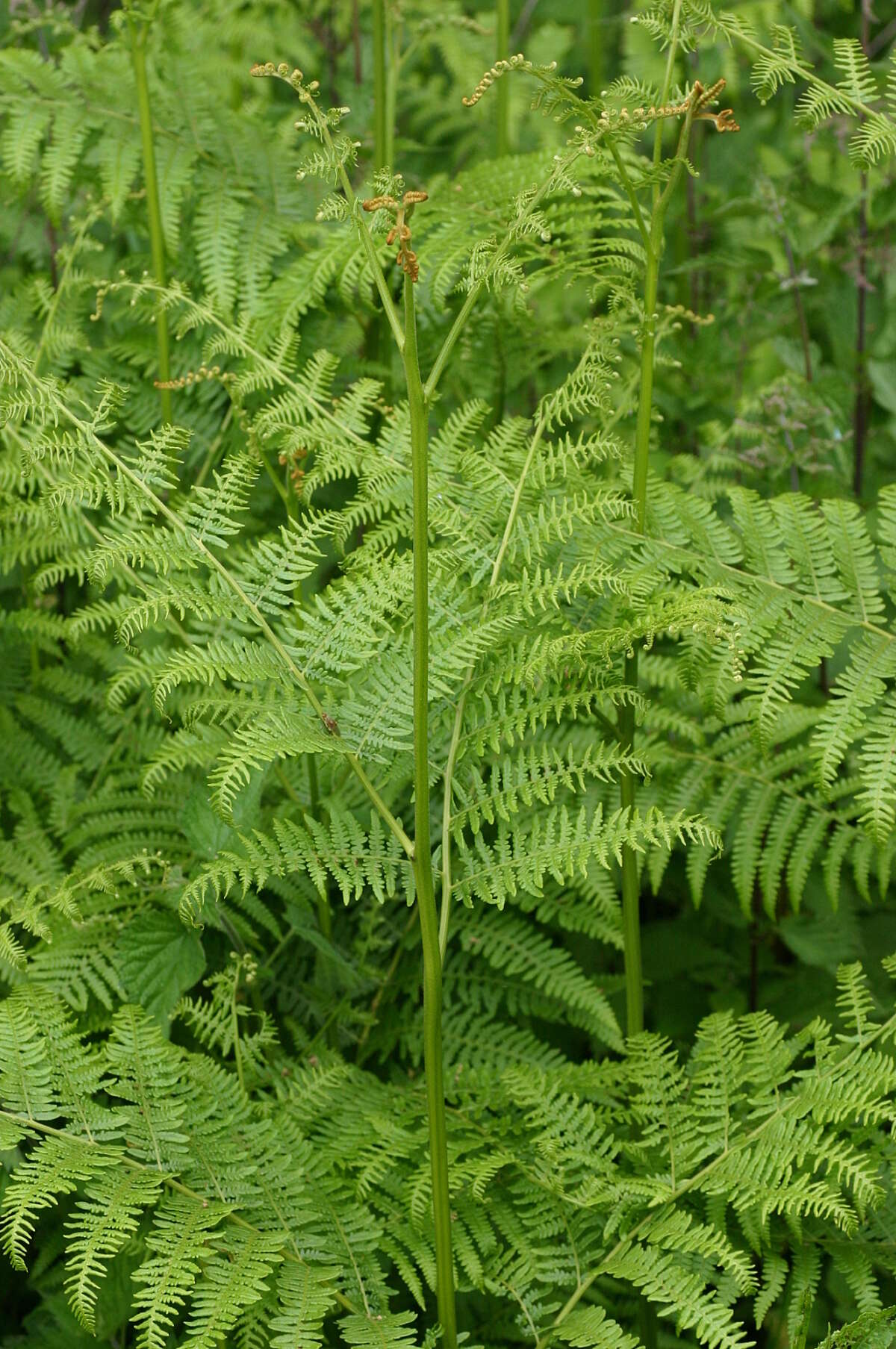Bracken

Other names
Brackenfern, brake
Latin names
Pteridium aquilinum (L.) Kuhn., (Pteris aquilinum, Eupteris aquilinum)
Weed Type
Miscellaneous Weeds
Where would I find bracken?
Unusually for a fern, bracken is a very successful coloniser and is widespread, particularly on neutral to acid soils in western parts of the UK. Originally a lowland and woodland plant it now infests many upland areas. Bracken became more invasive following tree clearance and an increase in sheep grazing on upland grassland. The young rhizomes cannot tolerate waterlogging but improved drainage has allowed bracken to colonize formerly wet sites. The upper limit for bracken growth on hills results from the effect of frost and wind on the fronds. Bracken in coastal areas can suffer salt damage in high winds. The vigorous growth and dense foliage, shade out other vegetation aided by the deep litter layer that builds up. The litter gives some protection from frost and from fire.
Bracken is a very variable plant and is often separated into different species, sub-species and varieties. Patches usually consist of several genetically distinct individuals.
Bracken can cause poisoning in stock animals although sheep and cattle normally avoid it, as do rabbits. In non-ruminants it causes a vitamin deficiency leading to staggers in horses. In ruminants, it causes ulceration and blood loss in cattle and blindness in sheep. The fronds are most toxic at the newly emerged or crozier stage. The fronds become less toxic with age but it is important that bracken cut for animal bedding should have died back entirely. The rhizomes are also poisonous and are a potential hazard to pigs that may uproot them and to cattle when ploughing exposes the rhizomes. Bracken is considered a human health hazard due to the carcinogenic spores. It also provides a habitat favoured by sheep ticks that transmit Lymes disease.
Few birds breed in bracken and it is said to have limited wildlife value. However, it is the preferred habitat for the whinchat and nightjar. There is a close relationship between bracken, violets and fritillary butterflies. Glands at the base of pinnae on the underside of bracken fronds secrete a substance attractive to ants.
Bracken was much used in the past for animal bedding, as a covering for potato clamps and as a source of potash for glassmaking. The fronds make good compost for use as a soil improver and together with manure and sheep.
Biology
Bracken is a perennial with an extensively branched rhizome system buried 10-45 cm deep. The rhizome system consists of thick storage organs that run deep underground and thinner, shallow rhizomes on which the fronds are borne. A high proportion of rhizomes may be found in the top 23 cm of soil but on deep soils the rhizomes may extend to a depth of over a metre.
Fronds generally emerge in May and arise singly from short lateral branches of the rhizome. A dormant bud at the base of each frond can provide a replacement if the main frond is lost or damaged. Fully developed fronds represent just a fraction of the potential fronds. Those that develop first in the main flush of emergence become the fertile fronds. Plants need to be 3-4 years old before fertile fronds are produced. Spores ripen from July to August and are shed until October. A frond may produce several million spores but the sexual phase of reproduction is delicate and requires the right amount of moisture. Sporelings are susceptible to fungal diseases and prolonged frosts.
The fronds die off in the autumn frosts. Severe winter frosts kill the apices of the rhizomes and late-spring frosts can damage the emerging fronds. The litter of dead fronds from the previous year provide some frost protection.
Does bracken spread easily?
The spores persist in the soil and can remain viable for up to 10 years. However, burial studies suggest there is considerable predation by insects. The development of new plants from spores requires constant moisture and freedom from frost, conditions that less likely to be met outside of woodland. Spores are not therefore considered a major source of spread.
Individual rhizomes have a lifespan of just a few years but the rhizome system is persistent. In Finland, individual clones of bracken have been dated back to the Iron Age. Extension rhizomes that advance ahead of the main patch may grow more than a metre a year. Biochemical tests to determine the extent of spread for individual plants indicated a maximum dimension of 390 m.
Woodland clearance, burning and grazing pressure have contributed to the spread of bracken. Heavy grazing has reduced the competitive ability of palatable grasses allowing bracken to spread further and put greater pressure on the remaining grassed areas. A fall in the management of uplands and reduced use of bracken for other purposes has allowed expansion to continue unchecked.
Can I compost bracken?
Bracken can be successfully composted by chopping into small pieces and placing in either a hot or cool composting system. We recommend shredding or chopping up thick bracken stems as they can take a time to rot down. As bracken spores are not considered a major source of spread, you shouldn't have to worry about germination in the compost heap.